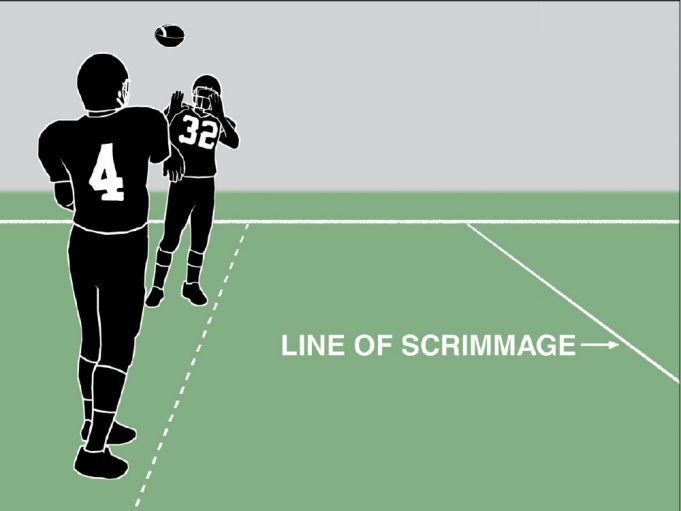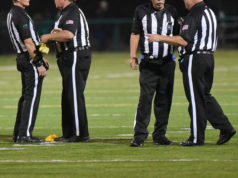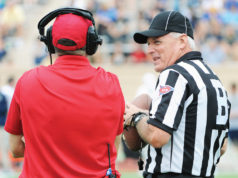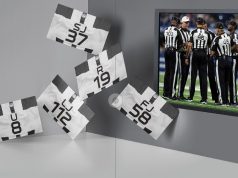I created a list of words and expressions commonly used by fans, coaches, announcers and sometimes by officials. However, nothing in my list appears in an NFHS or NCAA rulebook. My favorite non-football term is “lateral.” The correct term for what they’re describing is “backward pass.”
For NFHS, a backward pass is one thrown with its initial direction parallel with or toward the runner’s end line (2-31-5). In NCAA, a pass is ruled backward when the ball first strikes the ground, any player or an official behind the spot where the ball is released (2-19-2a).
When in question, it is a forward pass rather than a backward pass if thrown in or behind the neutral zone. In the PlayPic, if the receiver were to mishandle the pass, it should be ruled incomplete.
A backward pass (released overhanded or underhanded) can be thrown by any player possessing the ball anywhere on the field. Unlike a forward pass, it does not matter if an offensive player throwing a backward pass is behind, in or beyond the neutral zone.
Such a pass is possible after a change of possession, such as during a return of any kick or an advance after an interception or fumble recovery.
A snap is also considered a backward pass by rule (NFHS 2-40-1; NCAA 2-23-1).
The ball remains live if a backward pass initially hits the ground or is muffed and then lands inbounds. Officials should not blow their whistle when a backward pass is not caught. Either team can recover the loose ball and advance.
Play 1: At team A’s 40 yardline, A1 throws a pass into a strong wind. The initial direction of the pass is forward, but the wind blows the ball back to team A’s 35 yardline, where it hits the ground. Ruling 1: An incomplete forward pass in NFHS as the original direction was forward. A backward pass in NCAA as the pass first struck the ground behind the spot where the pass is released. Anyone can recover the loose ball and advance.
Play 2: A1 takes the snap and moves parallel to the line of scrimmage. At team B’s 10 yardline, he throws a backward pass to A2, the right tackle, who was trailing the play. A2 catches the ball at team B’s 15 yardline and runs across the goalline. Ruling 2: Six points for team A.
In general, it can be said that fouls applicable to legal forward passes do not apply to backward pass plays. If a backward pass was the only pass thrown during the down, there cannot be a foul for pass interference, illegal touching, ineligible receiver downfield or roughing the passer.
An in-flight backward pass can be batted backward by either team but may not be batted forward by the passing team (NFHS 9-7-3; NCAA 9-4-2). That is a 10-yard penalty enforced from the basic spot.
In NCAA, a backward pass cannot be intentionally thrown out of bounds to conserve time (7-2-1). That foul typically occurs near the end of either half when a team is trying to stop the clock. The penalty is five yards from the spot of the foul and loss of down.
Judson Howard, Los Angeles, is a replay official in the Pac-12 Conference. He officiated more than 20 years, many at the NCAA Division I level.
What's Your Call? Leave a Comment:
Note: This article is archival in nature. Rules, interpretations, mechanics, philosophies and other information may or may not be correct for the current year.
This article is the copyright of ©Referee Enterprises, Inc., and may not be republished in whole or in part online, in print or in any capacity without expressed written permission from Referee. The article is made available for educational use by individuals.


















